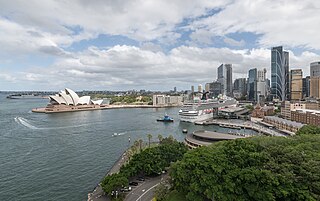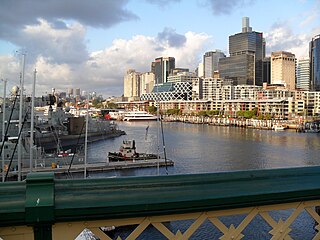
Darling Harbour is a harbour adjacent to the city centre of Sydney, New South Wales, Australia that is made up of a large recreational and pedestrian precinct that is situated on western outskirts of the Sydney central business district.

Circular Quay is a harbour, former working port and now international passenger shipping terminal, public piazza and tourism precinct, heritage area, and transport node located in Sydney, New South Wales, Australia on the northern edge of the Sydney central business district on Sydney Cove, between Bennelong Point and The Rocks. It is part of the local government area of the City of Sydney.

Circular Quay railway station is a heritage-listed elevated commuter rail station that is located on the City Circle route, serving the Circular Quay precinct of the Sydney central business district in New South Wales, Australia. It is served by Sydney Trains T2 Inner West & Leppington, T3 Bankstown and T8 Airport & South line services.

King Street Wharf is a mixed-use tourism, commercial, residential, retail and maritime development on the eastern shore of Darling Harbour, an inlet of Sydney Harbour, Australia. Located on the western side of the city's central business district, the complex served as a maritime industrial area in the early and mid 20th century. It was redeveloped as part of extensive urban renewal projects around Sydney Harbour in the 1980s and 90s. The complex is host to a cluster of nine wharves, with the first two wharves currently in use by private ferry operator Captain Cook Cruises and a third decommissioned by Sydney Ferries.

Circular Quay ferry wharf is a complex of wharves at Circular Quay, on Sydney Cove, that serves as the hub for the Sydney Harbour ferry network.

Milsons Point ferry wharf is located on the northern side of Sydney Harbour serving the Sydney suburb of Milsons Point. It is next to Luna Park and the Sydney Harbour Bridge. It is served by Sydney Ferries Parramatta River and Pyrmont Bay services operated by First Fleet and RiverCat class ferries.

McMahons Point ferry wharf is located on the northern side of Sydney Harbour serving the Sydney suburb of McMahons Point. It is served by Sydney Ferries Parramatta River and Pyrmont Bay services operated by First Fleet and RiverCat class ferries.

Balmain East ferry wharf is located on Sydney Harbour serving the Sydney suburb of Balmain East.

Barangaroo is an area of central Sydney, Australia. It is at the north-western edge of the Sydney central business district and the southern end of the Sydney Harbour Bridge. It is part of the local government area of the City of Sydney. The area was used for fishing and hunting by Indigenous Australians prior to colonial settlement. The area is inclusive of The Hungry Mile, the name harbourside workers gave to the docklands area of Darling Harbour East during The Great Depression, where workers would walk from wharf to wharf in search of a job, often failing to find one.

Double Bay ferry services connect wharves in Sydney's Eastern Suburbs with Circular Quay by commuter ferry. The services are provided by Sydney Ferries, an agency of the Government of New South Wales. The route is coloured dark green on the current Sydney Ferries network map. SuperCats are the primary vessel on the route with some Double Bay services operated by First Fleet ferries.
The Taronga Zoo ferry service is a ferry route in Sydney, New South Wales, Australia. It connects Taronga Zoo with the transport hub at Circular Quay. The route forms part of the Sydney Ferries network. In 2013, the Taronga Zoo ferry service was given the designation of F2 as part of a program to number all Sydney Ferries, Sydney Trains and light rail lines. Some F2 Taronga Zoo services are combined with F6 Mosman services, extending to Mosman Bay.
Inner Harbour ferry services was a name used for ferry services connecting suburbs on the foreshore of the inner Sydney Harbour with Circular Quay by commuter ferry. Since 2017 this name is no longer used and all services have reverted to individual names

Parramatta River ferry services connect suburbs along the Parramatta River in Sydney with Circular Quay by commuter ferry. The services are numbered F3 and form part of the Sydney Ferries network.

Bayview Park ferry wharf is a commuter wharf located in the Sydney suburb of Concord, New South Wales, on Hen & Chicken Bay. It is situated adjacent the namesake Bayview Park reserve, and upon the site of the historical Burwood ferry wharf, where Canadian exiles from the 19th century Lower Canada Rebellion landed in Sydney. Bayview Park was originally serviced by a Matilda Cruises route, before being included on Sydney Ferries' Parramatta River service in 2006, after a brief one-year service by Palm Beach Ferries. Services to the wharf were decommissioned by Sydney Ferries in October 2013, alongside Balmain West after patronage declined to a weekly average of 28 passengers. No operators currently service the wharf, although the structure still remains, with plans to return private ferry services to the wharf as part of a redevelopment project for a factory in eastern Concord.

Pyrmont Bay ferry wharf is located on the western side of Darling Harbour serving the inner-city Sydney suburb of Pyrmont. It is located adjacent to the Australian National Maritime Museum and close to The Star Casino.

The Pyrmont Bay ferry service, officially known as F4 Pyrmont Bay, is a commuter ferry service in Sydney, New South Wales. Part of the Sydney Ferries network, it is operated by Transdev Sydney Ferries and services the Lavender Bay and Darling Harbour areas. It began operation on 25 October 2020, and replaced the western half of the F4 Cross Harbour ferry service. Emerald-class ferries and SuperCat ferries operate the service.

The White Bay Cruise Terminal is a terminal for cruise ships on Sydney Harbour. The terminal is located at the eastern end of the White Bay wharves, on the northern shore of White Bay. It opened on 15 April 2013 as a replacement for Wharf 8 on Darling Harbour which closed to make way for the Barangaroo development.

The Cross Harbour ferry service, officially known as F4 Cross Harbour, was a commuter ferry service in Sydney, New South Wales. Part of the Sydney Ferries network, it was operated by Transdev Sydney Ferries and serviced the Darling Harbour, Lavender Bay, Rose Bay and Watsons Bay areas.
The 2010s saw many developments relating to transport in the Australian city of Sydney, New South Wales. The decade saw a substantial investment in infrastructure, including a new airport, motorway projects, light rail lines, Australia's first metro system, the new Waratah fleet and the demise of the non-air conditioned S sets from the rail network. Planning and branding of public transport services became substantially more centralised.


















